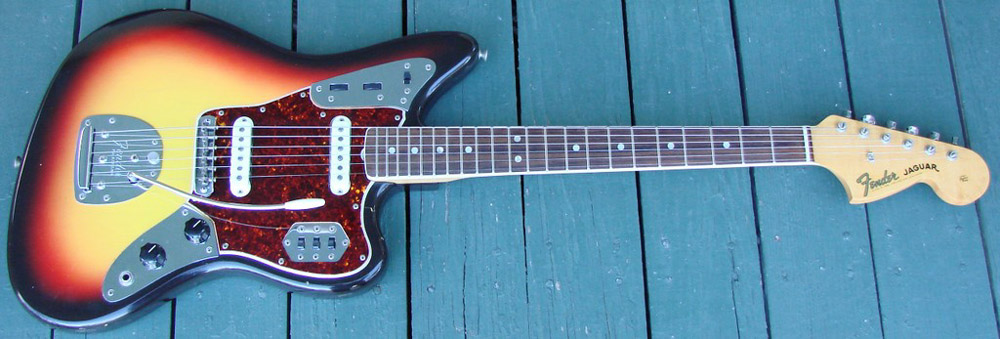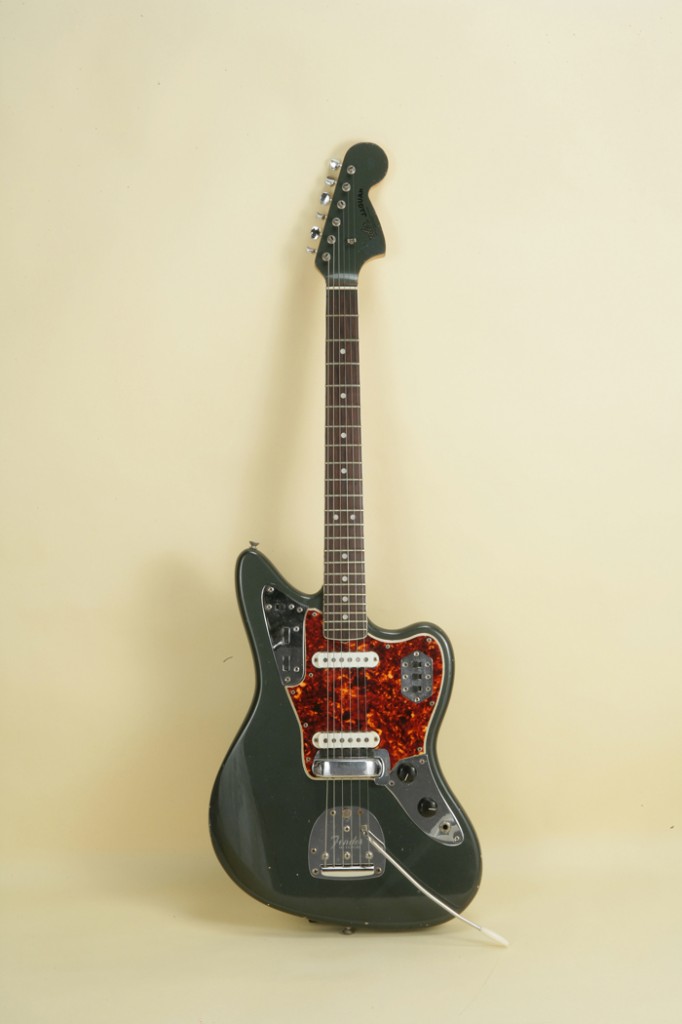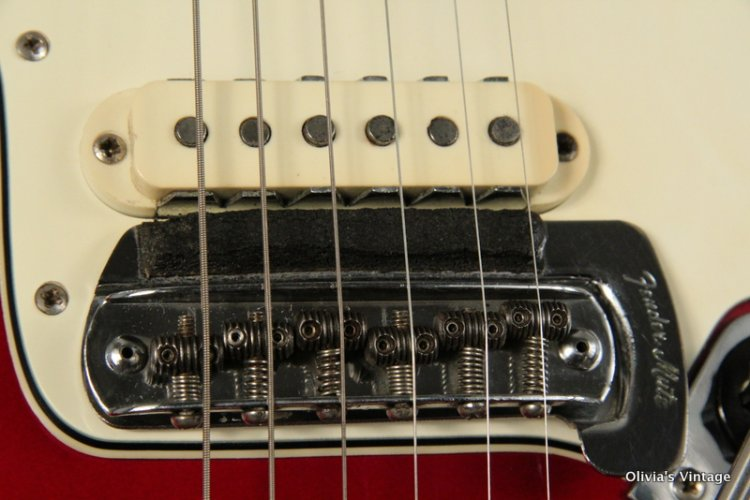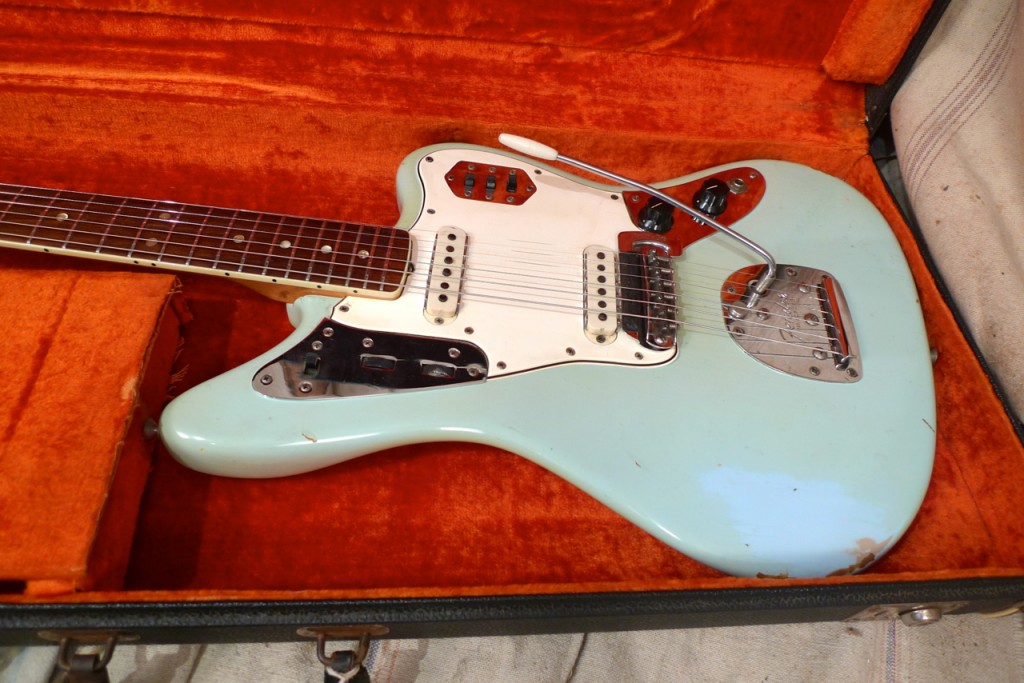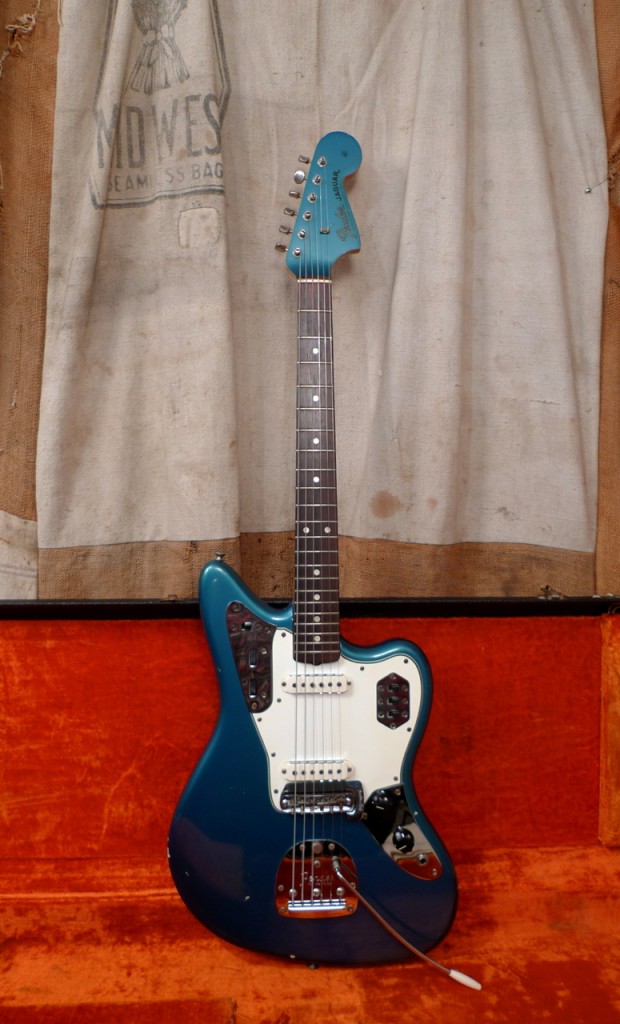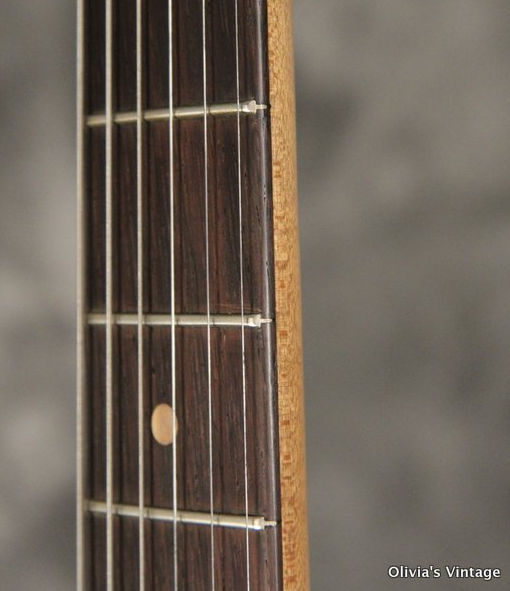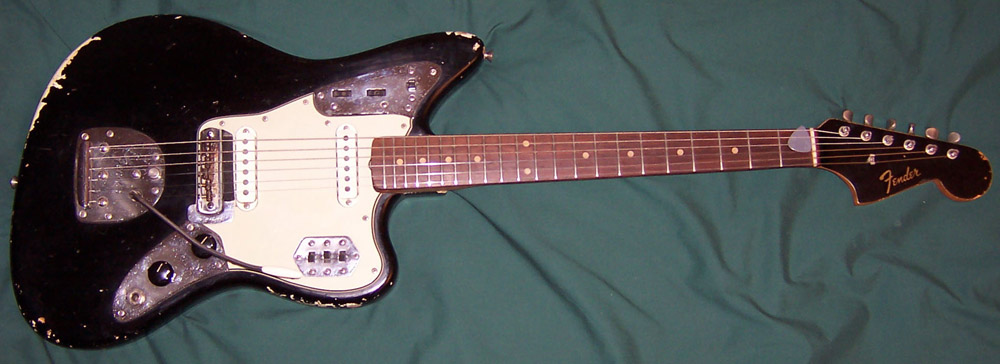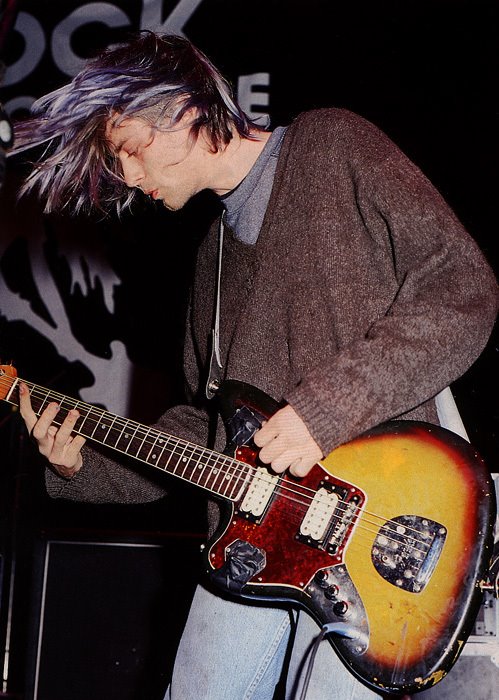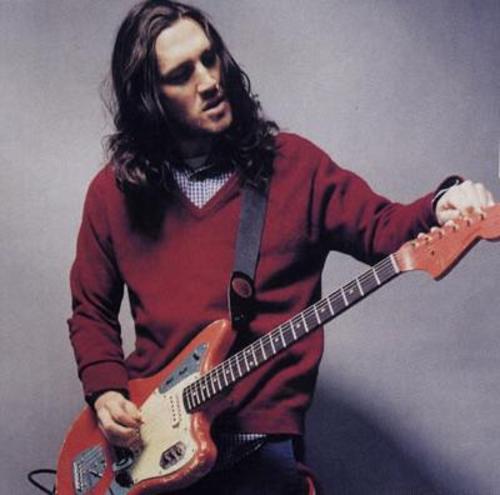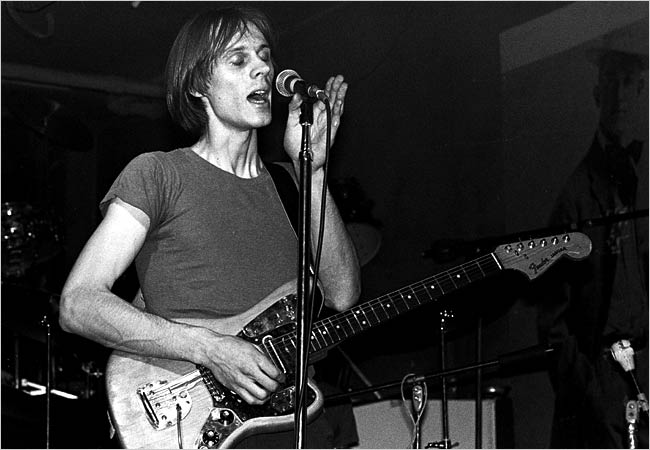Nearly immaculate 66 Jaguar in Sunburst finish (Image courtesy www.fenderjaguar.net)…
There might not be another guitar in the world that has had such a scrappy rise to fame and fortune as the Fender Jaguar. From a debut full of big hopes, to a slow decline into the cheap seats, to a meteoric resurgence that ended in a permanent place in guitar history, the Jag has had quite a ride so far. Equally loved and hated by guitar players and collectors, the Jaguar is a one of a kind guitar, and my personal all-time favourite.
Amazing condition 1965 Jaguar in very rare Charcoal Frost finish (Image from Jay Rosen)…
A Quick HIstory-
Introduced by Fender in 1962, the Jaguar came loaded with all sorts of bells and whistles, and was meant to be Fender’s new top-of-the-line model (priced accordingly higher than a Stratocaster!) For better or worse, this plan didn’t succeed. Most customers felt the Jag was a bit too flashy or weird looking, and the Stratocaster remained the king of the Fender line-up. Fender then began marketing the Jaguar largely as a “Surf Guitar”, as Brian Wilson and The Beach Boys were known for playing them at the time. They also tried to lure customers in by offering custom nitrocellulose lacquer finishes for a 5% add-on to the sticker price. But alas, even the cool finishes couldn’t do much to boost the popularity of the Jaguar. By the late 60’s the Jaguar had been relegated to the backseat of Fender’s line-up, and production of the original guitar finally ceased entirely in 1975.
The Guitar Itself-
Jaguars were unique in many ways. The most obvious thing is their shape. The “Offset Contoured Body” had a bent, almost distorted look to it. It was apparently designed to rest more comfortably against your torso, although in my opinion this is a bit of a canard. Most likely it was just a design choice to make the guitar look unique and cool.
Next up was the neck. Jaguar necks are a 24 inch scale, with 22 frets. This is in opposition to to Stratocasters as well as the Jaguars bigger sibling, The Jazzmaster, which both had a 25.5 inch neck scale. The shorter neck is often considered a bit easier to play, but more importantly, this shorter scale contributes greatly to the jangly sound that Jaguars are known for.
What about all those switches? The Jaguar was designed to run on two circuits, a lead and a rhythm. The idea was that you could set the pick-ups up the way you wanted them to sound for the lead circuit with the bottom three front switches and knobs. The rhythm circuit has its own set of knobs but is unaffected by the front lower switches. So then while playing, you could move back and forth from rhythm to lead sounds by hitting the switch at the top of the guitar up and down. This offered a lot of range for lead sounds, as well as the ability to move into a fuller sound for rhythm. A very cool set-up, but one that isn’t honestly used that much on stage, at least not by the indie rockers of later years.
Photo showing all the switches, knobs, and selectors on a Candy Apple Red Jaguar (image from Olivias Vintage Guitars)…
The last big point that was unique among Jaguars was the bridge. This is a real love it or hate it point for guitar players as it relates to the Jag. The Jaguar came with a patented “Floating bridge and tremolo system.” Basically it was a very cool but also very over designed and fiddly system, that frankly was beyond the needs and often the understanding of the people playing the guitar. Imagine that Ferrari built a car that had 20 gears instead of 5, along with multiple controls for the suspension, and 50 different positions for the steering wheel, and you start to get an idea of what a Jaguar bridge is like. The most common complaint however is actually not the over-design of the bridge in general , but a big glaring “oops” moment on Fender’s part. The actual saddles that the strings sit in were shaped like sideway barrels with saw-toothed grooves. So there were multiple grooves for each string, and they weren’t cut deep enough to securely hold the string! In practical terms , that means if you hit the strings hard they start skipping from one groove to another and your guitar is instantly way out of tune. All that said, some people love those bridges. Others, like myself, opted to switch them out for Mustang bridges, which had deeper single grooves, or in recent years, the beautifully designed Mastery Bridge.
Photo showing the original bridge of the Jaguar , with barrel saddles and the original string mute (image from Olivias Vintage Guitars)…
Finishes-
The Jaguar originally came in the standard trademark Fender Sunburst nitrocellulose lacquer finish, but as mentioned above, Fender quickly added the option of custom colour nitrocellulose lacquer finishes. So you by the mid-60’s you could buy a Jag in standard Sunburst for about $490, or take one in a Candy Apple Red finish or Lake Placid Blue for a few dollars more (complete with a matching headstock.) These custom colour finishes were one of the highlights of Fender’s mid-60’s design choices. Someone over at Fender had the truly genius idea to take a cue from Detroit and the American auto industry, and started painting the guitars these great custom car colours. Fender had a standard range “special” finishes that they offered, but in fact you could get the factory to paint your new guitar in any colour you wanted, as long as the colour could be supplied by DuPont. The most common custom colours were Olympic White and Candy Apple Red. Other more rare colours included Ocean Turquoise, Lake Placid Blue, Shoreline Gold, Sonic Blue, Shell Pink, Charcoal Frost, Seafoam Blue, Inca Silver, Fiesta Red and Burgundy Mist (occasionally called Champagne Mist). Jaguars that still have their original finish bring a big premium today in comparison to their Sunburst counterparts, especially for very rare colours like Charcoal Frost, Shell Pink or Burgundy Mist.
Very nice 1966 Jaguar in Sonic Blue finish. Notice the bound neck on this one. (Image from Southside Guitars, Brooklyn, NY)…
Another nice Jag in Lake Placid Blue finish (Image from Southside Guitars, Brooklyn, NY)…
Changes-
When CBS bought Fender in 1964, there began a slow succession of changes to the Jaguar, mostly aesthetic, but some more critical than others. The first thing to change was that the clay dots used to mark the fretboard were replaced with pearl dots. The first big change in my opinion was in 1965, when the neck acquired a binding around the edge. These necks have always seemed a bit thicker and stickier to me, and I much prefer the pre ’65 unbound necks. Around 1967 -1968 Fender stopped using nitrocellulose lacquer and switched to the cheaper and safer acrylic lacquer most people use today. It doesn’t wear as easily or develop checking (cracking) on the surface, but it’s not as beautiful as nitro lacquer by a long shot. This was maybe the first move in a cheapening of the guitar, and the first sign of it’s eventual discontinuation in 1975.
Unbound neck and clay dot markers on an earlier Jag. (image from Olivias Vintage Guitars)…
A nice original early Jag in custom Black finish. (Image courtesy www.fenderjaguar.net)…
Rebirth-
One side-effect of the Jaguar never quite catching on is that it became an affordable guitar for lots of punk and indie rock kids. For decades even a used Stratocaster could still be quite a chunk of change, but a used Jaguar could be bought for peanuts. Tom Verlaine of Television and Jonathan Richman of The Modern Lovers were early converts in the late 70’s, followed by Thurston Moore and Lee Ranaldo of Sonic Youth in the early 80’s. Elvis Costello also played a Jag in his heyday, and John Squire of The Stone Roses played a signature modified Jag. Johnny Marr of The Smiths and later Modest Mouse is also a known devotee. By the late 80’s the grunge guys had fully embraced the Jaguar, with J Mascis of Dinosaur Jr. and the boys from Mudhoney regularly playing Jags. Mascis and Sonic Youth would eventually play mostly Jazzmasters, but the Jaguar had one fan that rocketed it back into the spotlight – Kurt Cobain. When Nirvana‘s Nevermind hit the airwaves in 1991, the Jaguar got a push that Leo Fender never could have dreamed of, and it instantly became the must have guitar for young men in cardigans everywhere, and sadly for us (at the time) young musicians, also became a bit pricey for the first time since its debut. To further cement its place in alternative rock history, the Jaguar was also the guitar of choice for John Frusciante, during his first and most influential tenure with the Red Hot Chili Peppers. Thus the Jag was reborn and pushed into the realms of fans and collectors, as well as players.
Kurt Cobain playing his very rare lefty Jaguar, in Sunburst finish with bound neck and switches covered in duct tape…
John Frusciante with his early 1963 era Jag in Fiesta Red finish…
Tom Verlaine of Television performing at CBGB’s …
Buyers guide-
Not all jags are born equal, and internet buying is still a dodgy proposition, since the most important thing with any guitar is how it feels and sounds, not how it looks. There are subtle differences in the shape of the necks and the feel of the fretboards that will appeal to different players. There’s also just a strange magic in some guitars that makes them feel better than others, and you can’t see that in a jpeg. That said, looks count and you can still expect to pay more for a custom colour Jag than a Sunburst. An original Sunburst model averages about $3500, while custom finishes can range from $4000 to $12,000, depending on the colour. Also, the earlier models tend to be the more sought after guitars (especially “Pre-CBS” era) and are thus priced higher than later versions, so watch out for that as well. Whichever year or colour catches your eye, as with most vintage items, try to get as clean and original example as possible. I would start by searching gbase, which is a great online marketplace for guitars of all sorts. You can also always try and wade through the muck on eBay, as occasionally there are deals to be had by private sellers if you know what you’re looking for, but there are just as many bad deals as good so watch out. And of course, if you want to drop $32.5k on one, you can always buy the late, great Marc Bolan‘s Jaguar here! A last word of advice though – don’t be in a hurry. There are lots of these guitars in the world, and they tend to change hands pretty frequently. Wait for the right one. And remember to play it, not just hang it on the wall!!!



